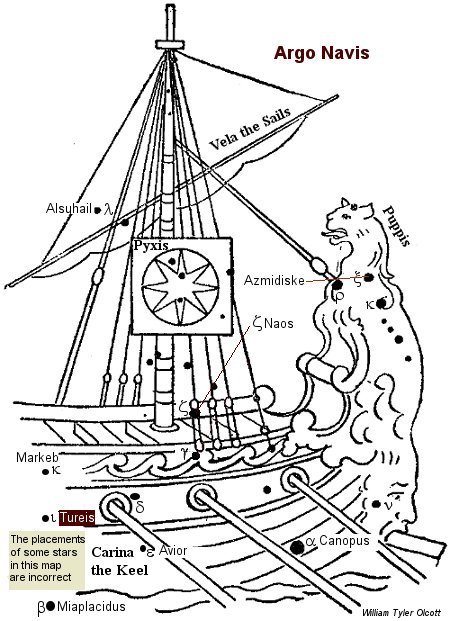| Fixed star: TUREIS | |
| Constellation: Iota (ι) Carina in the Ship Argo Navis | |
| Longitude 1900: 03LIB58 | Longitude 2000: 05LIB20 |
| Declination 1900: -58.51′ | Declination 2000: -59.15′ |
| Right ascension: 09h 17m | Latitude: -67.06′ |
| Spectral class: F0 | Magnitude: 2.2 |
The history of the star: Tureis
from p.74 of Star Names, Richard Hinckley Allen, 1889.
[A scanned copy can be viewed on this webpage
 Iota (ι) Carina, Tureis, is a pale yellow star in the Keel of the Ship Argo Navis
Iota (ι) Carina, Tureis, is a pale yellow star in the Keel of the Ship Argo Navis
According to WikipediaTureis is a traditional Arabic name for two different stars: this star iota Carina, and also rho Puppis
This was the Latins’ Scutulum, or Little Shield, the Arabians’ Turais, probably referring to the ornamental Aplustre at the stern of the Ship in the subdivision Carina; but the 17th century English orientalist Thomas Hyde, quoting it as Turyeish from Tizini, said that the original was verbum ignotum, and suggested that some one else should make a guess at it and its meaning. The English astronomer Smyth (1788-1865) wrote of it as "corresponding to the (Greek) Aspidiske of the second-century Greek astronomer Ptolemy"; but the latter described it as being in the Akrostolion, Gunwale (according to this website the akrostolion is the ornament placed on the stem of an ancient Greek ship, thus symbolizes sea trade), and located kappa (κ), xi (ξ), omicron (ο), pi (π), sigma (σ), and tau (τ) in the Aspidiske, or Aplustre, where they are shown today. The Century Atlas follows the English astronomer Smyth (1788-1865) in calling iota (ι) Aspidiske. It is visible from the latitude of New York City.
Star Names, Their Lore and Meaning, Richard Hinckley Allen, 1889, {Page 74}].
The astrological influences of the constellation Carina
No myths or astrological interpretations are associated with the constellation Carina because this constellation had always been seen as part of the constellation Argo Navis, the Great Ship, until French astronomer Nicolas Louis de Lacaille in 1752 subdivided Argo Navis into Carina (the keel of the ship), Puppis (the poop), and Vela (the sails), plus a subordinate division of Argo now called Pyxis Nautica. The constellation Argo Navis represents the ship in which Jason brought the Golden Fleece from Colchis, said to be the first ship ever built.
The astrological influences for the whole constellation of Argo Navis, the Great Ship: According to Ptolemy the bright stars are like Saturn and Jupiter. Argo is said to give prosperity in trade and voyages, and strength of mind and spirit, but it has been observed to accompany cases of drowning, a notable instance being furnished by the horoscope of Shelley, where Argo occupied the 8th house and contained the Sun, Venus and Uranus. Drowning is particularly to be feared when Saturn afflicts the Moon in or from Argo. It is probably on account of this constellation that Virgo, especially the first decanate, is frequently found to be connected with drowning. [Robson, p.30.]